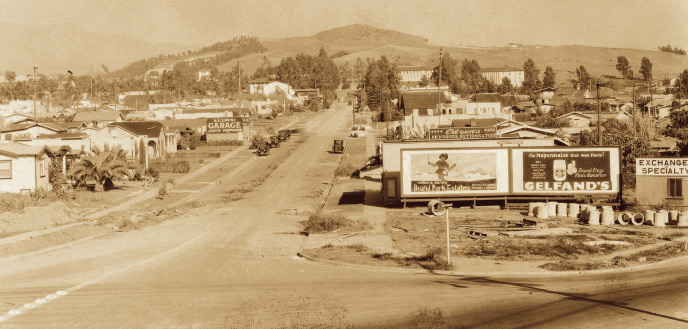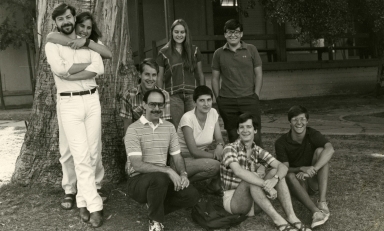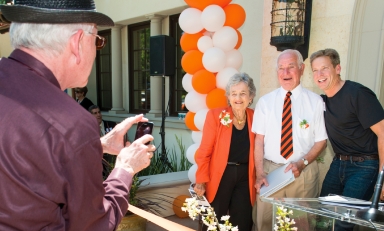
A visionary president, an ambitious land syndicate, and a leap of faith led Oxy from the comforts of Highland Park to its permanent home—but it didn't come easy
In August 1905, five Occidental trustees and their wives shared a summer vacation on Catalina Island. While enjoying the sun and sea, they had serious business to discuss: finding a president to succeed Guy W. Wadsworth, who in his eight-year tenure had guided the College from temporary quarters in downtown Los Angeles (after fire destroyed the original Boyle Heights building) to a new and growing campus in Highland Park.
"The claims of many men were canvassed," recalled interim president William Stewart Young, "but all were found wanting in our estimation." Then one day, Elizabeth Walker, the wife of board president Hugh K. Walker, said, "You men are trying to find a college president. I'll tell you who you should get, that is John Willis Baer."
The 44-year-old Baer—then associate secretary of the Board of Home Missions of the Presbyterian Church in New York—was an unusual choice. He had no experience in higher education, no advanced degree, and had never even attended college. What Baer possessed, however, was energy, charisma, name recognition, and connections with the wealthy and powerful. As Young told the story, Mrs. Walker's suggestion was like a bolt out of the blue: "We knew at once we had sighted the man for whom we were looking."Baer politely rejected the trustees' initial "modest proposal," but his resistance only deepened their resolve. According to Young, the prospective president softened while addressing the students during his first campus visit, but the deal was sealed in the Los Angeles realty office of Orson T. Johnson, where Johnson and fellow trustee Lyman Stewart personally guaranteed Baer the princely salary of $5,000 per year for five years—a remarkable sum considering that Wadsworth had been paid just $2,000 and no professor earned more than $900.
It soon became clear that the new president was worth the investment. Baer—who fondly referred to Occidental as the "Princeton of the West"—quickly moved to strengthen the faculty and the curriculum to compete with the more rigorous standards of established eastern schools. College enrollment nearly doubled during his first three years of leadership, reaching a high of 251 with an additional 174 in the preparatory academy. By this time, it was obvious that the 11-year-old Highland Park campus would not be adequate for the first-rate liberal arts college that Baer envisioned.
Once a "squirrel-infested grainfield," in the colorful description of 1907 graduate, professor, dean, and College historian Robert Glass Cleland, the small campus was now hemmed in by streets and streetcar lines in the rapidly growing urban community of Highland Park. Three large buildings, several smaller ones, and an athletic field were all squeezed into 10 acres between Monte Vista and Pasadena Avenue (now Figueroa Street), neatly bisected by the Southern Pacific Railroad—which emerged from a steep grade as it passed through the school grounds.
The main College building, the Hall of Letters, was built so close to the tracks that lectures had to pause for several minutes whenever a train would slowly pass. (Future silent movie cowboy Fred Thomson 1910 recalled that, for fun, he would jump on the train near its front, run along the top of the cars, and jump off near the back, landing at the same spot where he had boarded.) A recent addition of some 13 acres, across Avenue 50 from the rest of the campus, had not yet been developed, but there was nowhere else to go.
On May 3, 1909, the Occidental Board of Trustees adopted a brief but bold resolution: "It is the intention of this Board that when a proper location, that is commensurate with the needs of Occidental College, is available, that the institution shall be relocated." A five-member committee formed to confer with Baer "as to sites, offers, and other details" was chaired by William L. Green, a wealthy St. Louis grain merchant who had begun to invest heavily in Pasadena real estate in 1904 and joined the Board three years later.
Despite the limitations of the Highland Park campus, the decision to move was a leap of faith. The Hall of Letters and Stimson Library had been built at great expense just a few years earlier, and with a $202,000 endowment—the first in the school's history—the College was in better financial condition than it had ever been before.
Word of the decision apparently spread rapidly in the academic community. The College briefly flirted with the prospect of a merger with Pomona—Pomona!—which offered a campus in the San Gabriel Valley, some 40 miles east of Los Angeles, with plenty of room for expansion. (A similar proposal had been considered and rejected in 1896, after the Boyle Heights fire.) Occidental had a growing student body and a dynamic president in Baer, whom Pomona wanted to lead the merged institution. By mid-July, however, Oxy trustees rejected the offer because they believed it was "not wise to remove from the growing city of Los Angeles."
Two months later, Green reported an impressive offer from James G. Garth and W.A. Roberts of Highland Park. Garth and Roberts would give the College 75 acres of as-yet undeveloped land in the "Montezuma tract," located between the Highland Park campus and the Eagle Rock Valley, where a former farming community was fast developing into a small city. The developers would sell up to 15 additional acres for $1,200 per acre. In return, the College would have to begin building within two years and spend $75,000 on improvements in three years.
Located just outside the L.A. city limits—little more than two miles from its Highland Park locale and a short, 5-cent ride from downtown on a newly laid streetcar line—the site provided enormous potential to grow while maintaining the goal of being a force for Christian higher education in Los Angeles. "Geographically and from a scenic standpoint, the site is attractive," Green reported, "but it will be quite expensive ground to grade, on account of the contour." Despite this concern, the Board resolved to accept the offer and authorized the site committee to consummate the deal.Although the gift was generous, Garth and Roberts were not motivated by altruism. They were the primary players in a land syndicate that also included Samuel McRay and Ralph Rogers (whose home later became the Fiji House and is now the site of Samuelson Alumni Center). The syndicate had recently purchased 200 acres, including the land offered to Occidental, and planned to use the College as a draw to sell residential lots around the campus. It was no accident that much of the gifted land was steeply sloped—as trustee Green noted in his report—but the land that the syndicate kept was flat and could be easily developed.
On Jan. 5, 1910, Garth and McCray signed a contract with "The Occidental College of Los Angeles." The details were somewhat different from the original offer, though the effect was essentially the same: Garth and McCray gave the College 64.479 acres and sold Oxy an additional 21.38 acres for $13,030, a total of almost 86 acres. The developers would provide a water line, and the College would pay half the cost of grading "Campus Road" and half the property taxes for the fiscal year. Garth and McCray would pay for other roads in the surrounding area and subdivide the lots for residential development, with no commercial buildings, dance halls, or gambling establishments. Houses built facing Campus Road would have a minimum value of $3,500 and "no stable, cow shed, chicken pen or corrals, or similar structures," would be built within 300 feet of the road.
On January 9, the W.A. Roberts Realty Co. ran a splashy full-page advertisement in the Los Angeles Herald for "Occidental Park—The New Site of Occidental College—An Ideal High-Class Residence Location." The ad depicted an upscale community of 700 lots that promised everything but the moon. "Never before in the history of Los Angeles has a tract been placed on the market under such favorable conditions and auspices as those attending the opening of Occidental Park. … The background is the towering Sierra Madre Range, and nowhere else in Southern California can such beauty of hill and valley and plain, crowned by the most gorgeous sunsets, be found."
The map accompanying the text portrayed fictional streets, but the layout of the College grounds, athletic field, and buildings was very similar to a more formal 1913 drawing by architect Myron Hunt, who—along with then-partner Elmer Gray—was involved before the land contract was signed.
Sales began briskly, with the fledgling Eagle Rock Sentinel reporting that 18 lots had been sold by March 24. It speaks to the still-speculative nature of the venture, however, that the 18 lots were purchased by four men, presumably for resale. Among them was Samuel McCray, who had signed the land agreement but apparently dropped out of the syndicate and became an individual investor.
Not long after the land was secured, Baer announced plans for the new campus to the students during morning chapel, interrupting a presentation of lantern slides of Chinese missions to display drawings by Hunt. Later, the entire student body walked to the new campus, a stroll of about 2½ miles. Arthur N. Young 1910 remembered gazing on the "sloping open fields with a rise to the hills." Classics professor William D. Ward waxed more poetically: "Spread out among the hills, with the mountains in the background and from the highest eminence catching an occasional glimpse of the sea, the situation is one of unsurpassed beauty."The highest eminence had been given to the College separately at the same time as the Garth contract, as an outright gift from Eagle Rock real estate developers Godfrey Edwards and Otto Wildey, who asked for nothing more than "permission to reach the balance of our land by the road which you will probably construct to the summit." The parcel of two to three acres, part of today's Fiji Hill, was intended for an ambitious observatory that was never realized.
At Commencement in June 1910, Baer presented a statement from the Board of Trustees, proudly announcing "important changes of unusual interest." From the trustees' point of view, the most important was a change in the charter that ended direct control of the school by the Presbyterian Church and made it a non-sectarian institution, though fully dedicated to the principles of evangelical Christianity—clearly spelled out in the new charter. The trustees were especially pleased that the Los Angeles Presbytery had approved the change unanimously and continued its financial support of the school.
The other big change, of course, was obtaining the new campus. Grading Campus Road was expected to begin in the next 60 days, and $143,000 had already been raised toward a $500,000 building fund. The trustees felt confident that they could invite the public "to celebrate Occidental's Quarter-Centennial in no better way than by dedicating and moving into the new buildings on the new campus, if all be well, in 1912." Despite their enthusiasm, the celebration would have to wait.
Myron Hunt—who had recently severed his partnership with Gray—signed a new contract Jan. 14, 1911, as sole architect of the campus project. He would be paid 5 percent of the cost of any buildings or other permanent improvements that he designed, but only when the construction contracts were actually signed. Even a bill for $737.77, presented by Hunt and Gray for services up to that time, would be paid by a voucher out of later funds. For Hunt, the Occidental campus became the great project of his professional career, and later correspondence makes clear that he often "carried" the College financially.
In February 1911, as fundraising and planning continued, the College became a central issue in plans to incorporate the community in the Eagle Rock Valley as Eagle Rock City. Although some civic leaders hoped to include the campus and the Los Angeles trolley line in the new city, Baer and other College leaders wanted to retain their independence and convinced the county Board of Supervisors to "leave the college in the country." This prompted a letter to the Eagle Rock Sentinel from Godfrey Edwards, who had donated the summit land and considered the College essential to plans for Eagle Rock City. "I wish to state that since the Board of Supervisors has modified our lines cutting off the Occidental College campus and surrounding property, that I am very strongly opposed to incorporating what is left. What is the use of incorporating the rind—and leaving out the heart (Occidental)?"
Edwards' choice of words did not sit well with proud residents of the Eagle Rock Valley, who, while appreciating the potential of the College, did not consider themselves the rind. On Feb. 25, 1911, they voted to incorporate on the lines drawn by the Board of Supervisors, leaving the College and most of the trolley line outside its borders. The population of the new city was about 600, not much larger than the College community would be when, and if, it arrived.At Commencement in 1911, Baer regretfully announced that the campus would not be ready for occupancy in September 1912 as originally planned and that classes would continue on the Highland Park campus for the next two years. In a bit of historical revisionism, he also revealed that the "true" Quarter-Centennial would be in September 1913, not 1912 as previously announced, because although the College had been founded in 1887, the first class had not entered until September 1888.
This news echoed ominously among the more skeptical citizens of Eagle Rock City, who were beginning to wonder whether the College would be coming at all. They had seen little action so far, and the terms of the contract gave the school until Jan. 8, 1912, to break ground on the first building or the land would revert to its original owners. Board of Trustees treasurer William Patterson, a Los Angeles banker (for whom Patterson Field is named), addressed the College's doubters in an interview with the Eagle Rock Sentinel. "Do the people really think we are fools?" he asked the reporter. "Does anyone believe we are going to lose those 90 acres of land donated for the college site, and now worth at least $1,000 an acre?"
Fortunately, Patterson's questions would prove moot. By late 1911, funding was secured for the first three campus buildings, a fact happily announced to the students by Baer before Christmas break and trumpeted in the Los Angeles Times with the headline "Occidental on the Joy Wagon." Johnson Hall of Letters was underwritten by the College's most generous supporters to that time, Anna and Orson T. Johnson, who had earlier bestowed the Hall of Letters on the Highland Park campus, provided a third of the original endowment, and paid half of Baer's salary. Fowler Hall of Science, a memorial to lumber and mining magnate Eldridge M. Fowler, was a gift from his daughter, Kate Fowler, and his granddaughter, Marjorie Fleming. The men's dormitory, James Swan Hall, was funded by Frances B. Swan as a tribute to her late husband.
Although construction began in January 1912, it was soon halted by the discovery of an underground stream that flooded the foundation of Johnson Hall. Caused by heavy rains that had seeped into fault lines running down from Fiji Hill, the water was so plentiful that it threatened to halt construction completely before being controlled. (In 1958, construction of Norris Hall of Science was temporarily halted by a similar stream.) It became clear that school could not open on the new site in 1913, either, and the Quarter-Centennial gala would again be postponed.
The long delays, while frustrating to College leaders, proved even more costly to the land developers, whose sale of lots had stalled while the campus remained empty. By October 1912, the Eagle Rock Sentinel reported that the promoters of the Occidental Park tract were unable to meet their financial obligations. The same article also made clear that the financial troubles did not affect another housing tract called Campus Park promoted by Godfrey Edwards, who seemed to be doing well with the "rind." Although the financial details of the Occidental Park venture are unknown, the early College history by Cleland suggests that James Garth took the largest losses. Even so, Garth survived to sell land in Long Beach. Edwards and Wildey went on to build the Los Angeles Coliseum and develop Granada Hills.
Finally, in March 1914, the three buildings were near enough to completion that the College could hold its long-awaited Quarter- Centennial celebration. The festivities began with an assembly at the Highland Park campus, during which co-founder William Stewart Young delivered an address detailing the first 25 years of College history, a story of stubborn victory over a long parade of challenges. He did not touch on the more recent construction difficulties, as they were "modern history," and "each of you knows what your historian knows about the wonderful transformation." Most important of all was that "Occidental College was no longer an experiment but an assured educational fact. …Yesterday is history. Today is opportunity. Tomorrow is with God and you."That evening a dinner for close to 800 people was held in Hamburger's Department Store, a massive Beaux Arts building in downtown Los Angeles. The next morning, the new campus was officially dedicated, beginning with an academic procession that formed in Johnson Hall and led to what the student paper called the "upper quadrangle" between Johnson and Fowler halls. There, after a scripture reading and prayer, the keys to the new buildings were passed from E.P. Clapp, chairman of the building committee, to Board president Frank Flint, and finally to Baer, whose vision for the College had led to this day. Each building then received its own dedication, followed by a long parade of speakers and a congratulatory telegram from President Woodrow Wilson.
After this ceremonial opening, much work remained to be done, and classes continued for the rest of the year in Highland Park—though Commencement was held on the new campus. The Occidental Academy, which had helped to sustain the school through hard times, had been phased out as public high schools opened in the area, and the Board hoped to sell the old campus site to the city of Los Angeles. (The property was ultimately bought by the Highland Park Land Company in 1916.) The College could now focus all of its energies to become, in the words of Young, "one of the best colleges of Liberal Arts and Natural Sciences in the land."
The final moment of the great transition came in September 1914, when 322 young men and women, by far the College's largest enrollment to that time, arrived on the brand-new campus. The scene that awaited them—the stately facades of Johnson and Fowler halls on the rise, Swan Hall on lower ground, all surrounded by rolling hills and distant mountains—had a raw, yet sublime academic elegance. And though there has been impressive development in the last century, the same scene, more polished but no less sublime, awaits a new generation of students this fall.
Paul Robert Walker '75 picked Occidental over Pomona because of Oxy's Los Angeles locale. For additional reading on the era, we recommend John Willis Baer (2000), Jean Paule's biography of Oxy's sixth president; and the newly published Pioneers of Eagle Rock, edited by Eric H. Warren '69 and Frank F. Parrello.








